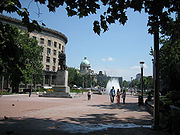
Nikola Pašic Square
Encyclopedia

Serbian language
Serbian is a form of Serbo-Croatian, a South Slavic language, spoken by Serbs in Serbia, Bosnia and Herzegovina, Montenegro, Croatia and neighbouring countries....
Cyrillic: Трг Николе Пашића) is one of the central town square
Town square
A town square is an open public space commonly found in the heart of a traditional town used for community gatherings. Other names for town square are civic center, city square, urban square, market square, public square, and town green.Most town squares are hardscapes suitable for open markets,...
s and an urban neighborhoods of Belgrade
Belgrade
Belgrade is the capital and largest city of Serbia. It is located at the confluence of the Sava and Danube rivers, where the Pannonian Plain meets the Balkans. According to official results of Census 2011, the city has a population of 1,639,121. It is one of the 15 largest cities in Europe...
, the capital of Serbia
Serbia
Serbia , officially the Republic of Serbia , is a landlocked country located at the crossroads of Central and Southeast Europe, covering the southern part of the Carpathian basin and the central part of the Balkans...
. Square is named after Nikola Pašić
Nikola Pašic
Nikola P. Pašić was a Serbian and Yugoslav politician and diplomat, the most important Serbian political figure for almost 40 years, leader of the People's Radical Party who, among other posts, was twice a mayor of Belgrade...
who served as mayor of Belgrade, prime minister of Serbia and prime minister of Yugoslavia. Formerly the square was named Marx
Karl Marx
Karl Heinrich Marx was a German philosopher, economist, sociologist, historian, journalist, and revolutionary socialist. His ideas played a significant role in the development of social science and the socialist political movement...
and Engels
Friedrich Engels
Friedrich Engels was a German industrialist, social scientist, author, political theorist, philosopher, and father of Marxist theory, alongside Karl Marx. In 1845 he published The Condition of the Working Class in England, based on personal observations and research...
Square.
Location
Located in the municipality of Stari GradStari Grad, Belgrade
Stari Grad is an urban neighborhood and one of 17 municipalities which constitute the Belgrade, the capital of Serbia. It encompasses some of the oldest sections of urban Belgrade, thus the name...
, Nikola Pašić Square lies in downtown Belgrade as the direct extension of Terazije
Terazije
Terazije is the central square and an urban neighborhood of Belgrade, the capital of Serbia. It is located in the Belgrade municipality of Stari Grad.- Location :...
. Named after Nikola Pašić
Nikola Pašic
Nikola P. Pašić was a Serbian and Yugoslav politician and diplomat, the most important Serbian political figure for almost 40 years, leader of the People's Radical Party who, among other posts, was twice a mayor of Belgrade...
, Serbia's famous early 20th century politician and Prime Minister, it overlooks the monumental building of the National Assembly and itself extends into Belgrade's longest street, King Alexander
Aleksandar Obrenovic
Not to be confused with Alexander I of Yugoslavia.Alexander I or Aleksandar Obrenović was king of Serbia from 1889 to 1903 when he and his wife, Queen Draga, were assassinated by a group of Army officers, led by Colonel Dragutin Dimitrijević-Accession:In 1889 Alexander's father, King Milan,...
Boulevard, while Dečanska Street connects it to the Republic Square.
History and characteristics
The square was built during the 1950s as part of a massive Terazije reorganization project. Inaugurated as the MarxKarl Marx
Karl Heinrich Marx was a German philosopher, economist, sociologist, historian, journalist, and revolutionary socialist. His ideas played a significant role in the development of social science and the socialist political movement...
and Engels
Friedrich Engels
Friedrich Engels was a German industrialist, social scientist, author, political theorist, philosopher, and father of Marxist theory, alongside Karl Marx. In 1845 he published The Condition of the Working Class in England, based on personal observations and research...
Square in honour of the famous communist idealogues, its original terrain was so hilly that lots of earth had to be removed in order to make its construction possible.
Subsequently in the late 1980s, it was one of the Belgrade's first toponyms to change its name with the loosening of the communist ideology.
Characteristics
A monument to Nikola Pašić was erected in the early 1990s. When the statue was to be erected, ideas of bringing back earth to the square in order to create the artificial hillock as a pedestal for the monument appeared, but were ultimately abandoned.The dominant architectural features in the square are the massive, Socialist Classicism
Stalinist architecture
Stalinist architecture , also referred to as Stalinist Gothic, or Socialist Classicism, is a term given to architecture of the Soviet Union between 1933, when Boris Iofan's draft for Palace of the Soviets was officially approved, and 1955, when Nikita Khrushchev condemned "excesses" of the past...
Dom sindikata (Trade Union Hall) building and one of the Belgrade's largest fountains. Museum of Yugoslav History is located across the fountain. Adjacent to the square is the Pionirski Park as well as the buildings of the Belgrade City Hall and the Presidency of the Republic.
The pedestrian section of the square is used for various public events, most notably open flower, honey, and book sales. On occasion, artificial ice rink
Ice rink
An ice rink is a frozen body of water and/or hardened chemicals where people can skate or play winter sports. Besides recreational ice skating, some of its uses include ice hockey, figure skating and curling as well as exhibitions, contests and ice shows...
or beach volley sand courts are put up as seasonal attractions in winter and summer, respectively.

